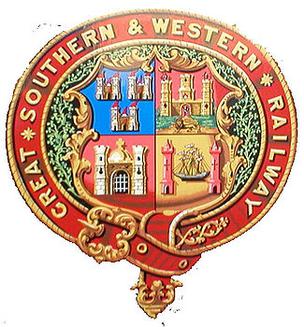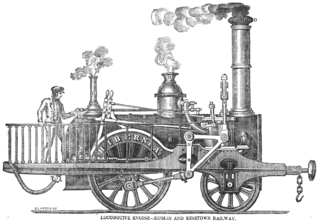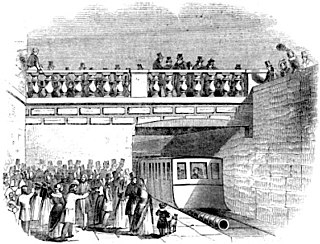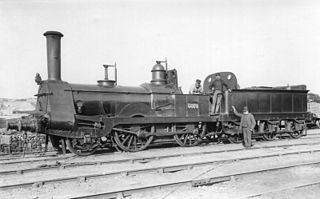
The Great Southern and Western Railway (GS&WR) was an Irish gauge railway company in Ireland from 1844 until 1924. The GS&WR grew by building lines and making a series of takeovers, until in the late 19th and early 20th centuries it was the largest of Ireland's "Big Four" railway networks. At its peak the GS&WR had an 1,100-mile (1,800 km) network, of which 240 miles (390 km) were double track.

The Dublin and South Eastern Railway (DSER), often referred to as the Slow and Easy, was an Irish gauge railway in Ireland from 1846 to 1925. It carried 4,626,226 passengers in 1911. It was the fourth largest railway operation in Ireland operating a main line from Dublin to Wexford, with branch lines to Shillelagh and Waterford. The company previously traded under the names Waterford, Wexford, Wicklow & Dublin Railway to 1848, Dublin and Wicklow Raillway (D&WR) to 1860 and Dublin, Wicklow and Wexford Railway (DW&WR) until 1906.

Grand Canal Dock railway station serves the Grand Canal Dock area in Dublin, Ireland.

The Dublin and Kingstown Railway (D&KR), which opened in 1834, was Ireland's first passenger railway. It linked Westland Row in Dublin with Kingstown Harbour in County Dublin.

The Dalkey Atmospheric Railway was an extension of the Dublin and Kingstown Railway (D&KR) to Atmospheric Road in Dalkey, County Dublin, Ireland. It used part of the Dalkey Quarry industrial tramway, which was earlier used for the construction of Kingstown Harbour. It was the first commercial atmospheric railway in the world.

Alexander Allan (1809-1891) was a Scottish mechanical engineer. He was born at Montrose, Angus, in 1809 and died at Scarborough, Yorkshire on 2 June 1891.
George Forrester and Company was a British marine engine and locomotive manufacturer at Vauxhall Foundry in Liverpool, established by Scottish engineer George Forrester. The company opened in 1827 as iron founders and commenced building steam locomotives in 1834.

Hibernia was a steam locomotive designed by Richard Roberts and built by Sharp, Roberts and Company in 1834 for the Dublin and Kingstown Railway (D&KR). The locomotive had vertical cylinders driving via bell cranks.

Broadstone railway works or simply Broadstone or the Broadstone was the headquarters for mechanical engineering and rolling stock maintenance for Midland Great Western Railway (MGWR). The complex grew around the Dublin Broadstone railway terminus.
Dublin, Wicklow and Wexford Railway (DW&WR) 11 built in 1896 was the predecessor to a total of twelve 2-4-2T locomotives to emerge from Grand Canal Street railway works between 1896 and 1910. Eleven of twelve lasted through to the early 1950s, the only loss being due to the Civil war, and despite attempts to replace them remained they remained vital to the running of the South Dublin services suburban services to Bray throughout their lives.
Dublin, Wicklow and Wexford Railway (DW&WR) 4 and 5 were a pair of 0-6-2T tank locomotives purchased from Kitson & Co. in 1897 and rebuilt as 0-6-0 tender Locomotives in 1908 due to a tendency to derail. Renumbered by Great Southern Railways to 448 and 449 they survived until 1940 and 1950 respectively.
The Dublin, Wicklow and Wexford Railway (DW&WR) Ariel Class refers to seven 2-2-2WT well tank locomotives built by Neilson and Company and introduced in 1865.
James Pim was the key person to the establishment and operation of the first passenger railway in Ireland, the Dublin and Kingstown Railway (D&KR), and the first commercial atmospheric railway in the world, the Dalkey Atmospheric Railway.

Swiftsure was first of eight or more similar locomotives with a single pair of driving wheels built by George Forrester and Company (Forresters) from 1834. The tank variant was the first passenger tank engine to enter service in the world.
Princess was the class lead for a set of five locomotives built by the Dublin and Kingstown Railway (D&KR) in their own Grand Canal Street works from 1841. Princess was both the first locomotive built in Ireland and the first locomotive to be completed by a railway company in the British Isles in their own workshops.
Star was a locomotive designed by Isaac Dodds of the 2-2-0 configuration and built in 1833 at the Horsley Coal & Iron Company, Tipton, Birmingham, England. Despite rebuilds, it was never a successful engine, and was scrapped in 1840.
Burgoyne was the class lead for a set of four locomotives, built by the Dublin and Kingstown Railway (D&KR). It was built in their own Grand Canal Street works from 1845.

Robert Coey (1851–1934) was a locomotive superintendent of the Great Southern and Western Railway (GS&WR) of Ireland from 1896 until 1911.

John Melling (1782-1856) was the locomotive superintendent for the Liverpool and Manchester Railway (L&MR) and contributed several railway engineering patents. Melling was a key person in the operation of the L&MR through the early pioneering days of the L&MR.
Thomas Fleming Bergin was an Irish civil engineer and early Irish railway official. He was the Company Clerk of the Dublin and Kingstown Railway (D&KR), the first public railway in Ireland. He was also responsible for the design of the Bergin Patent Spring Buffer, the buffering system that it used.










